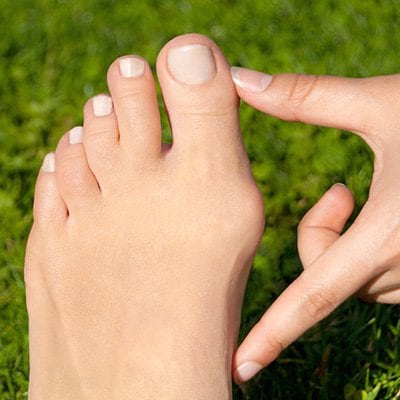Bunions

A bunion is a bony bump at the base of your big toe, which over time can become inflamed and make it painful to wear shoes. A bunion can cause the joint at the base of your big toe (metatarsophalangeal joint) to shift inward causing the joint to protrude from the base of your toe. This may also result in the overlapping of your second and third toes.
More than half the women in America have bunions, a common deformity often inaccurately blamed on wearing tight, narrow shoes, and high heels. The truth is that the hereditary bone structure of your foot has a lot to do with whether you are susceptible to bunions; if other people in your family have bunions you should limit the amount of time you spend in tight shoes and high heels.
Other Types of Bunions
Your pre-teen or teenager (especially girls aged 10-15) may develop an adolescent bunion at the base of his or her big toe. Unlike adults with bunions, a young person can normally move the affected joint but may experience pain and have trouble wearing shoes. Surgery to remove an adolescent bunion is not recommended unless your child is in extreme pain and the problem does not get better with changes in shoe wear. If your adolescent has bunion surgery before he or she is fully-grown there is a strong chance the problem will return.
A bunionette, or “tailor’s bunion,” is very much like a bunion, except it occurs on the outside of your foot near the base of your little toe. You may also have a hard corn and painful bursitis in the same spot. In cases of persistent pain or severe deformity, surgical correction is possible.
Bunion Prevention & Treatment
Comfortable, properly fitting shoes are important to your overall foot health no matter what your situation, but they are crucial if you are predisposed to bunions of any kind. Keep these guidelines in mind when you choose your footwear:
- Never force your foot into a shoe that doesn’t fit. If you’re not sure of the size of your foot, go to any reputable shoe store and have an associate properly size your feet for you.
- Choose shoes that conform to the shape of your feet. Go for shoes with wide insteps, broad toes, and soft soles.
- Avoid shoes that are short, tight or sharply pointed and those with heels higher than 2 1/4 inches. If you already have a bunion, wear shoes that are roomy enough or have a wide toe box as to not put pressure on it. This should relieve most of your pain.
- You may want to have your shoes stretched out professionally. You may also try protective pads to cushion the painful area. If your bunion has progressed to the point where you have difficulty walking, or experience pain despite accommodative shoes, you may need surgery.
When to Seek Care
If your bunions are painful and affecting your everyday life, you should schedule an appointment to be evaluated by your podiatrist.
Conservative methods of prevention and treatment can help with the symptoms of bunions, but the only way to truly correct the deformity is through bunion surgery. Bunion surgery realigns bone, ligaments, tendons, and nerves so your big toe can be brought back to its correct position. Podiatric surgeons have several techniques to ease your pain. Many bunion surgeries are done on a same-day basis (no hospital stay) using ankle-block anesthesia. A long recovery used to be common and included persistent swelling and stiffness, but advanced techniques have made downtime and recovery shorter than ever.